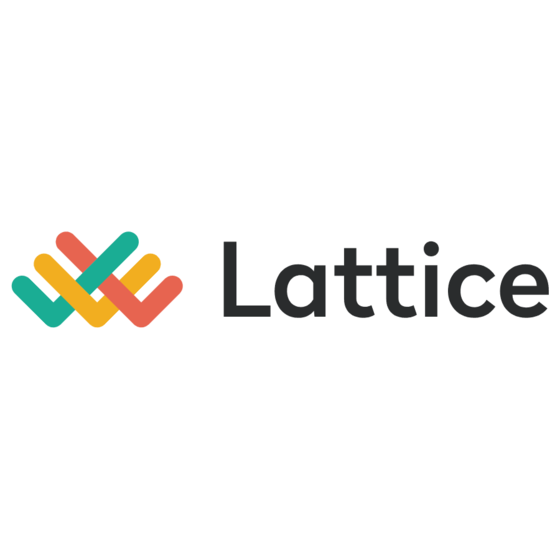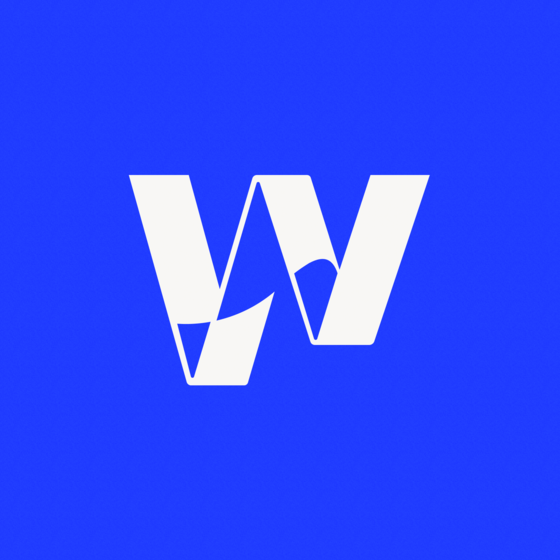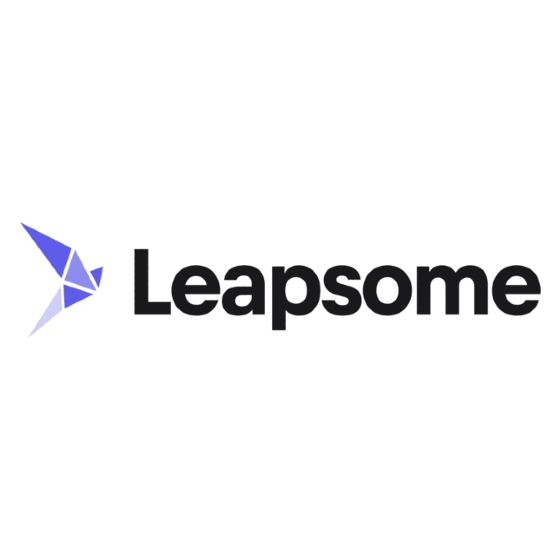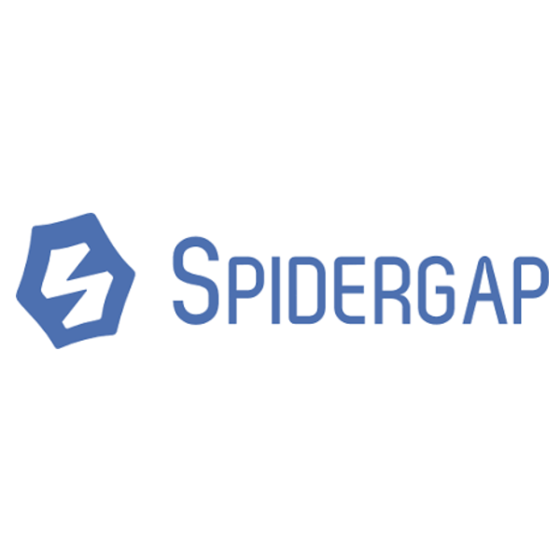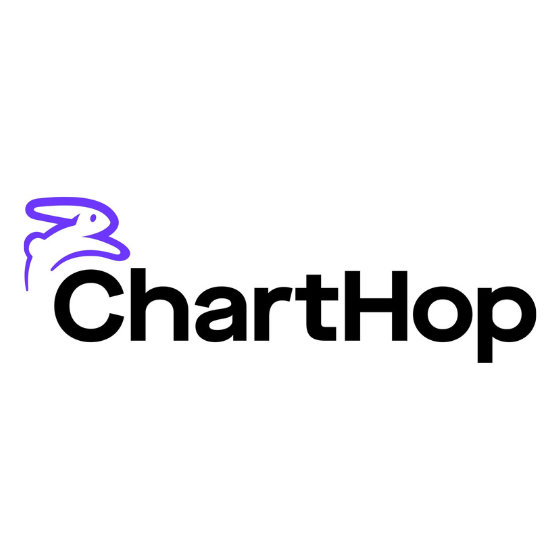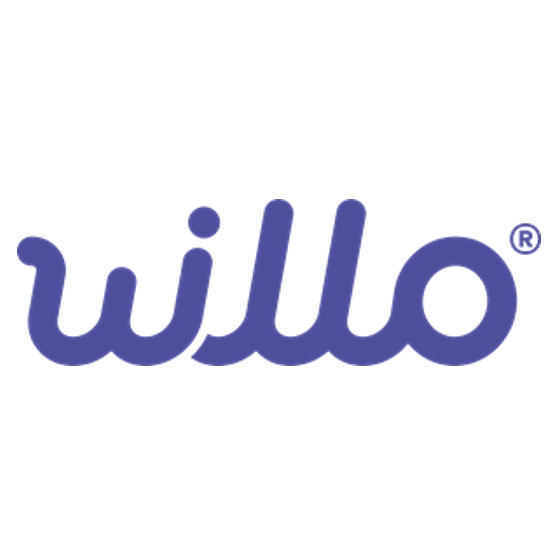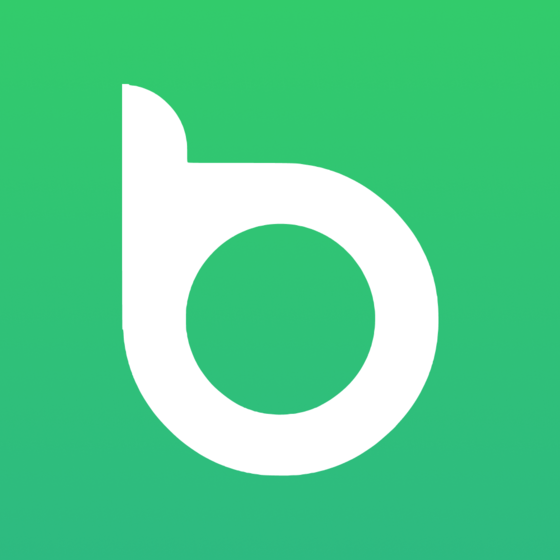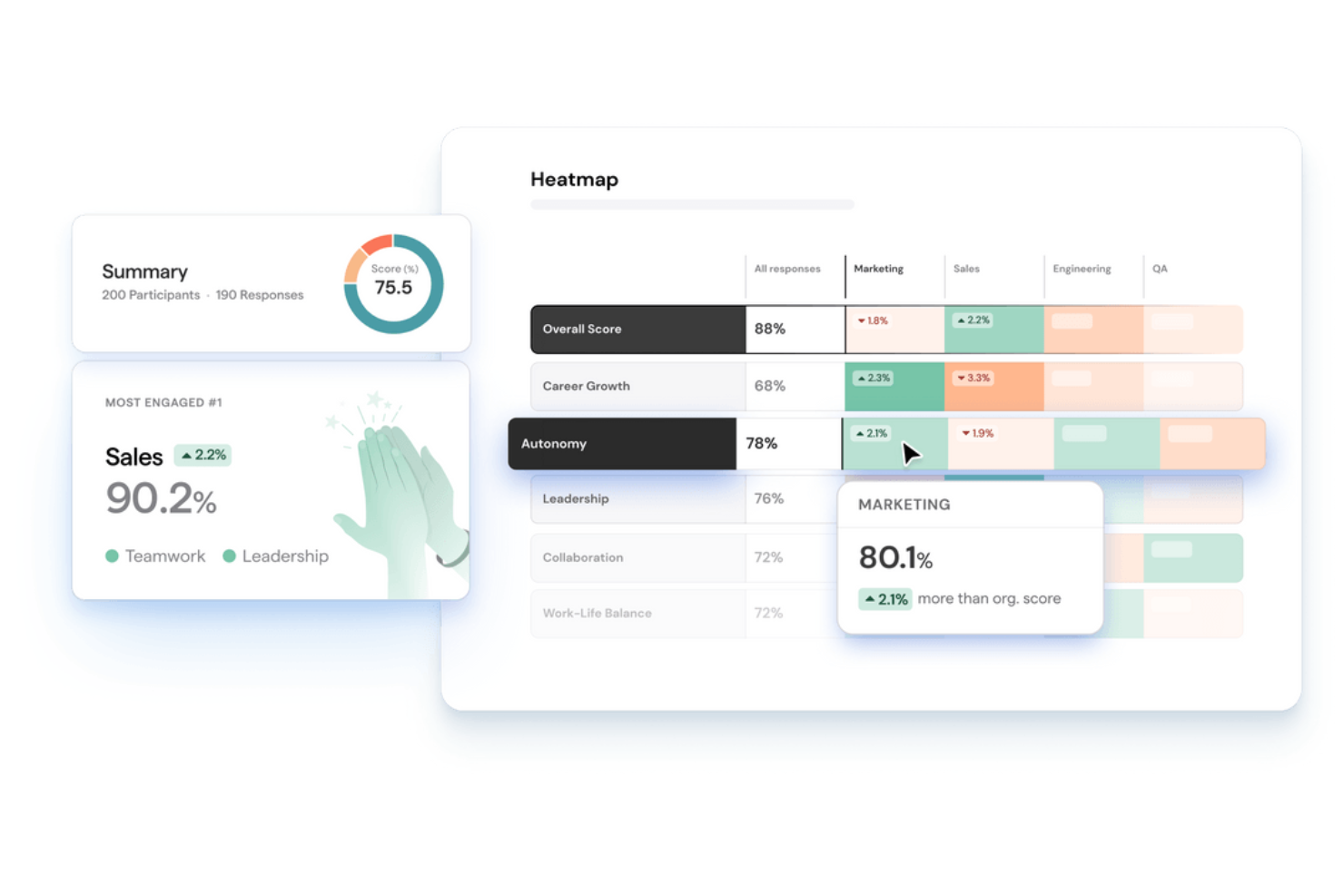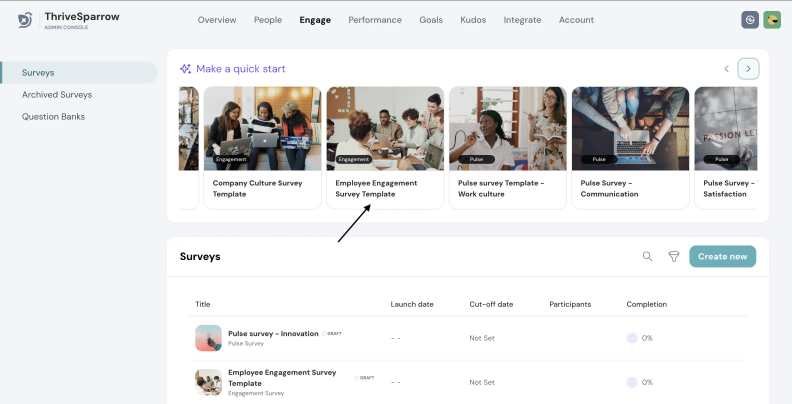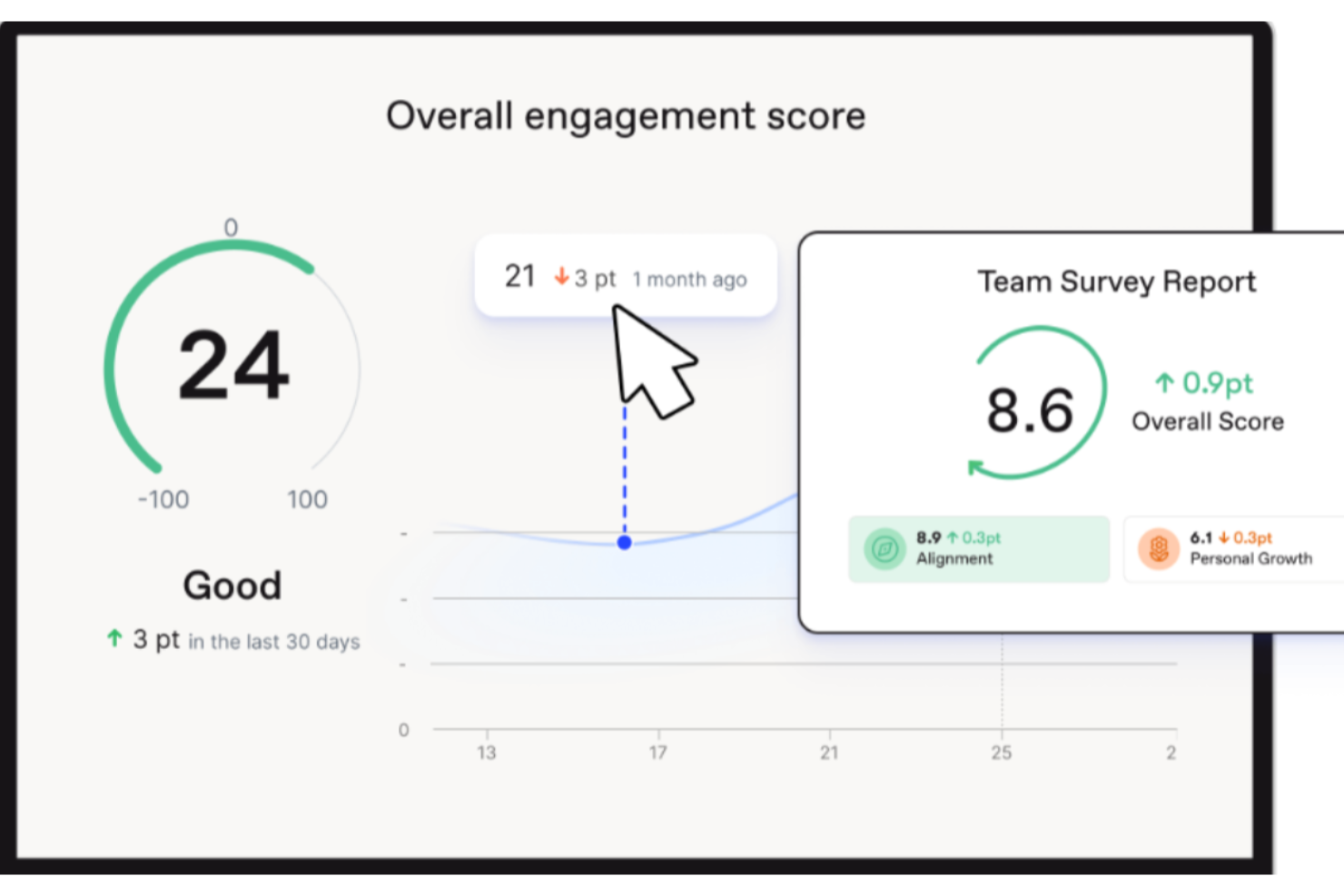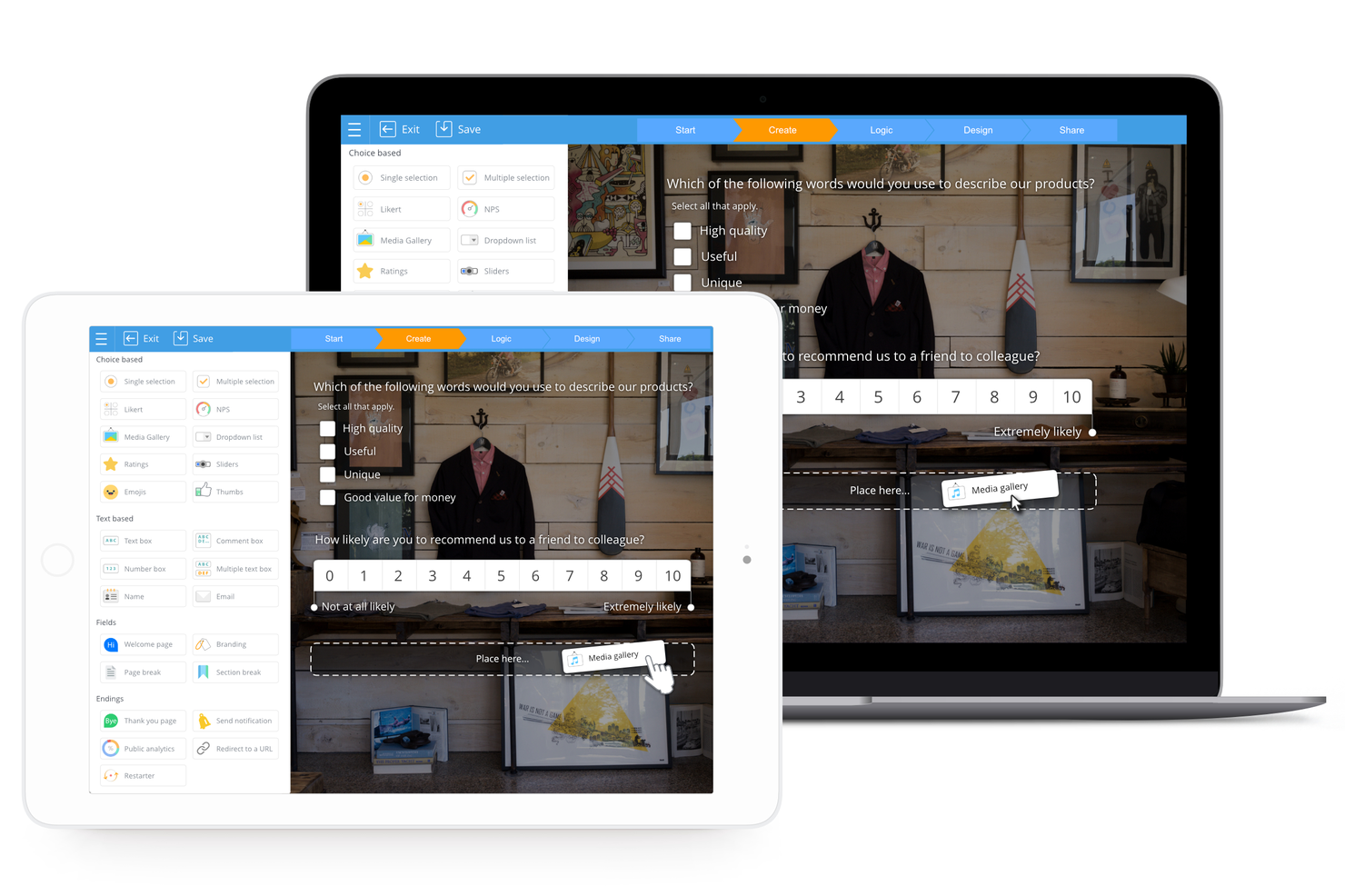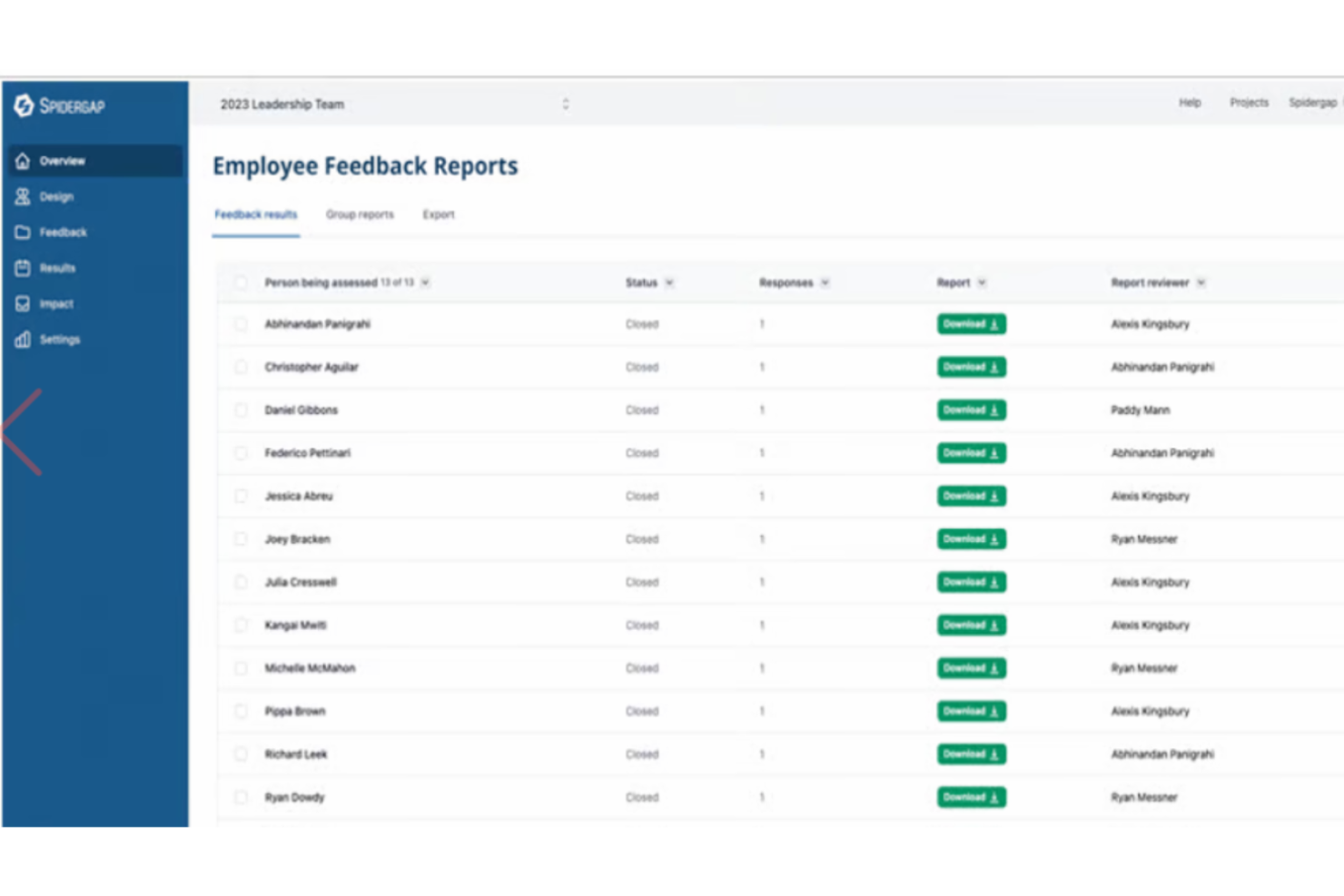10 Best Employee Survey Tools Shortlist
Here's my pick of the 10 best software from the 30 tools reviewed.
Talk through what you’re looking for. Get a custom shortlist based on your needs. No fees.
Employee surveys are a great way to get a read on employee engagement levels and unearth any issues that are prohibiting people from working to their full potential.
However, as you may have experienced, developing effective surveys is easier said than done.
Employee survey tools will help you to increase response rates, get richer responses, and analyze the data to take action.
Based on my experience using similar tools, in this article I review some of the top employee survey tools explaining what they're best for and the standout features of each tool to help you find the best fit for your specific needs.
Why Trust Our Software Reviews
We've been testing and reviewing HR software since 2019. During that time we've tested more than 2,000 tools for different HR use cases and written over 1,000 comprehensive software reviews.
As HR professionals ourselves, we know how critical and difficult it is to make the right decision when selecting software.
We invest in deep research to help our audience make better software purchasing decisions. Learn how we stay transparent, and take a look at our software review methodology.
Best Employee Survey Tools: Pricing Comparison Chart
This comparison chart summarizes pricing details for my top employee survey tool selections to help you find the best software for your budget and business needs.
| Tool | Best For | Trial Info | Price | ||
|---|---|---|---|---|---|
| 1 | Best tool for global, multilingual surveys | Free trial + demo available | From $29/month | Website | |
| 2 | Best for real-time pulse surveys | Free demo available | Pricing upon request | Website | |
| 3 | Best for performance and talent development | Free demo available | Pricing upon request | Website | |
| 4 | Best for real-time actionable feedback insights | 14-day free trial | From $2/employee/month | Website | |
| 5 | Best for science-backed survey templates | Free demo available | From $11/seat/month | Website | |
| 6 | Best for anonymous feedback | 14-day free trial + free plan available | From $5/user/month | Website | |
| 7 | Best for identifying survey themes | Free demo available | Pricing upon request | Website | |
| 8 | Best for connecting feedback with development | 14-day free trial | From $8/user/month | Website | |
| 9 | Best for real-time employee surveys | Free plan available | From $19/month | Website | |
| 10 | Best for reports that drive action | Free forever plan (up to 1 user) | Pricing upon request | Website |
-

ChartHop
Visit WebsiteThis is an aggregated rating for this tool including ratings from Crozdesk users and ratings from other sites.4.3 -

Willo
Visit WebsiteThis is an aggregated rating for this tool including ratings from Crozdesk users and ratings from other sites.4.8 -

Boon
Visit WebsiteThis is an aggregated rating for this tool including ratings from Crozdesk users and ratings from other sites.4.7
Best Employee Survey Tool Reviews
Here’s a brief description of each employee survey platform to showcase each tool’s best use case, some noteworthy features, and screenshots to give a snapshot of the user interface.
Deel is a global workforce management platform with employee surveys features as part of their HR operations package.
Why I picked Deel: Deel makes it easy to create effective surveys in the traditional sense and also quick polls in Slack. They have a range of templates to choose from to assess different perspectives and tools to help sort and analyze the responses.
Deel Standout Features and Integrations:
Features include a Slack integration to 1) create quick Slack surveys and polls that get 90% response rates on average and 2) automatically nudge people to complete surveys.
Integrations include Ashby, BambooHR, Expensify, Greenhouse, Hibob, Netsuite, Okta, OneLogin, Quickbooks, SCIM, Xero, Workday, and Workable. They also have an Open API that supports additional custom integrations as well.
Eletive is a people success platform that helps businesses improve employee engagement, performance management, and self-leadership. Its performance management tools enhance its capabilities as an employee survey tool.
Why I picked Eletive: When it comes to employee survey tools, Eletive stands out with its real-time pulse surveys, which offer immediate insights into employee engagement and feedback across the organization. These surveys are designed to be quick and frequent, helping companies continuously monitor and analyze employee sentiment. Additionally, the platform's intuitive dashboards and heatmaps make it easy to visualize this data.
Eletive Standout Features and Integrations:
Features include real-time pulse surveys to give an instant overview of how your organisation is feeling and what to focus on, targeted surveys for automatically sending surveys to the relevant employees e.g. onboarding or offboarding, and an anonymous employee chat to encourage candid feedback.
Integrations include ADP Workforce Now, CatalystOne, Employment Hero, Deel, BambooHR, Google Workspace, Gusto, Humaans, Sage HR, Workday, Zoho People, Paychex, Slack, Microsoft Teams, Okta, Personio, and more.
Mitratech Trakstar is a hiring and talent development platform offering a wide range of features and tools designed for attracting and retaining talent, employee development, and workforce engagement.
Why I picked Mitratech Trakstar: With Mitratech Trakstar’s employee engagement survey platform, HR leaders and talent development teams gain the resources they need to create better employee experiences. They can start a company-wide pulse survey using questions from the integrated survey library or create custom questionnaires to match current requirements and the kind of data they want to collect. HR can also send surveys automatically, covering any topic they want.
Mitratech Trakstar Standout Features and Integrations:
Features include an auto-schedule function that helps HR professionals collect employee feedback on a preset schedule, and response tracking that uncovers the true sentiments within their workforce at any given time. Users can also prompt check-ins at any time to maintain employee engagement and make sure individual employees and team members across the entire organization can voice their opinions on the company’s future initiatives.
Other features include 360-degree performance reviews and surveys to support the performance review process. HR professionals can set who has access to the 360-degree feedback, with the employee's manager retaining full control over the type of information that will be shared with the employee, such as constructive feedback or peer feedback.
Integrations include ADP Workforce Now, BambooHR, Google Workspace, Paylocity, Salesforce, Slack, Zoom, and others.
ThriveSparrow is a straightforward, user-friendly employee engagement and recognition platform.
Why I picked ThriveSparrow: Their employee engagement suite has multiple tools to get a read on employee sentiment including a huge bank of visually appealing and research backed surveys.
ThriveSparrow Standout Features and Integrations:
Features include the ability to quickly create surveys and customize them to your specific needs as well as AI-powered tools to help analyze data and create action plans for improvements.
Integrations include Slack, Bob, BambooHR, ADP Workforce Now, Zoho People, Sage HR, Paychex, ChartHop, Dayforce, Kenjo, Lano, Remote, Ping Identity, Okta, and many others.
New Product Updates from ThriveSparrow
New Survey-Builder
ThriveSparrow's updated survey-builder allows HR teams to create and distribute engagement surveys quickly, with guided question selection, branding, and distribution options. More details at ThriveSparrow Blog.
Lattice is comprehensive people management platform that offers tools for engagement, performance management, and people development.
Why I picked Lattice: Lattice's survey suite includes multiple survey types using science-backed templates. These range from pulse to eNPS, as well as industry benchmarking and AI analysis with actionable recommendations.
Lattice Standout Features and Integrations:
Features include the real-time reporting and analysis function with the ability to leave comments and responses and the feature to automatically send relevant surveys at set period e.g. onboarding and offboarding.
Integrations include Slack, Okta, Microsoft Outlook, OneLogin, Microsoft Teams, Microsoft Azure, Google Workspace, Jumpcloud, ADP, BambooHR, Namely, Personio, Gusto and others. Or you can access the Lattice API for further connections.
Workleap Officevibe is a leading employee experience tool used to monitor engagement and recognize good work.
Why I picked Workleap Officevibe: The platform has a range of surveys and tools to provide HR leaders and managers with real-time employee feedback and insights. This includes a bank of 122 pulse surveys, a custom survey builder, eNPS and DEIB surveys.
Workleap Officevibe Standout Features and Integrations:
Features include the ability to easily filter for engagement metrics, type, tone and the AI-powered real-time reporting feature that helps HR leaders and executives get a more complete view of what employees are feeling.
Integrations are available with Slack and Microsoft Teams.
WorkTango is an employee experience platform focused on using employee surveys and recognition and rewards to boost performance.
Why I picked WorkTango: Their survey tools helps you to get feedback from across the entire employee lifecycle with customizable survey templates based on recommendations from I/O Psychologists for onboarding, engagement, DE&I, M&A, development, and off-boarding.
WorkTango Standout Features and Integrations:
Features include research backed employee engagement surveys and real-time dashboards that are easy to interpret and utilize AI to identify themes, generate action plans, and even recommend learning.
Integrations include Microsoft Teams, Microsoft Outlook, Slack, 7Shifts, Access PeopleHR, ADP Workforce Now (U.S. only), Apple HealthKit, Azure Active Directory, Google Workspace, and more.
Leapsome is a cloud-based HR platform that offers employee performance management, engagement surveys, and personalized learning and development solutions.
Why I picked Leapsome: Leapsome offers a range of survey tools to create, administer, and analyze surveys. This then integrates with the rest of the Leapsome suite to develop and deliver new talent initiatives.
Leapsome Standout Features and Integrations:
Features include customizable survey questions and the ability to create surveys that can be anonymous or identified depending on the business's needs. Once the survey is launched, HR teams and managers can track responses in real-time and use AI to help analyze results including sentiment analysis of open-ended questions.
Integrations include Workday, BambooHR, Personio, Slack, MS Teams, Jira Software, calendar apps, and others.
SurveyLegend is a digital platform designed for creating and distributing surveys, forms, and polls, offering a variety of templates and customization options to suit different needs.
Why I picked SurveyLegend: It supports multilingual surveys, allowing for a broader audience reach, and offers white label surveys for brand consistency. The platform also features advanced options like logic and branching, real-time data analytics, and offers white label surveys for brand consistency.
SurveyLegend Standout Features and Integrations:
Features include a user-friendly drag-and-drop interface for creating surveys, and a variety of question types and the ability to add multimedia elements. You can also export your survey data into Google Sheets for further analysis, or enable automated email marketing campaigns based on your survey responses.
Integrations include Google Sheets, Mailchimp, and Salesforce.
Spidergap is a 360-degree feedback platform that helps organizations run employee development assessments and generate clear, actionable reports. Its primary use case is multi-rater feedback, but it also functions as an employee survey tool with customizable forms and ROI measurement features.
Why I picked Spidergap: I chose Spidergap because it focuses on clarity and usability in its reporting. While many survey tools overload you with charts, Spidergap highlights development priorities in a format that’s easy to understand and share. You can start with prebuilt templates or fully tailor your questions and workflows to your organization’s goals. The optional impact survey also gives you a way to evaluate whether your initiatives are working.
Spidergap Standout Features and Integrations:
Features include customizable 360-degree feedback templates, user-friendly reports that highlight key focus areas, and an impact survey to help assess post-survey outcomes. Reports are designed to support ongoing development conversations, not just one-time reviews.
Integrations include Google, Excel, and Intercom.
Other Employee Survey Tools
Here are a few more worthwhile options to help you collect employee feedback that didn’t make the list of the best employee survey tools list:
- Jotform
For enterprise surveys
- Vantage Circle
For customizable pulse surveys
- Empuls
For eNPS surveys
- Culture Amp
With a template library
- SurveyMonkey
For prebuilt forms and automated deployment
- IntelliHR
For pulse checks and sentiment analysis
- TINYpulse Engage
With meeting agendas and recognition
- SurveyLab
Drag-and-drop survey builder
- Teamspective
For integration with Slack or Teams
- Beams
For providing recommendations to employees
- Startquestion
Easy-to-use survey tool
- Zoho Survey
For real-time insights and analytics
- Betterworks
For additional employee engagement features
- Qualtrics XM
For analyzing large amounts of survey data
- Guusto
For targeting specific employee sub-groups
- PerformYard
For integrated performance and engagement
- Motivosity
For modular add-ons
- ClearCompany
For uncovering employee sentiment
- Sogolytics
For employee feedback analysis
- SurveySparrow
For engaging mobile-first survey designs
Related HR Software Reviews
If you still haven't found what you're looking for here, check out these other related tools that we've tested and evaluated:
- HR Software
- Payroll Software
- Recruiting Software
- Employer of Record Services
- Applicant Tracking Systems
- Workforce Management Software
Selection Criteria for Employee Survey Tools
Selecting the best employee survey tool is a nuanced process that hinges on matching your specific needs and challenges with the features and functionalities that will help you address them effectively.
My approach to evaluating these tools is grounded in personal trials and in-depth research, ensuring a comprehensive understanding of each platform's capabilities.
I also drew on my personal experience collecting employee feedback via surveys when I was an HR administrator.
In that role, I was the one preparing and analyzing surveys to improve the employee experience.
This helped me to pinpoint the standout features that will give you the best return on your investment and simplify the process for you.
Here’s a summary of the evaluation criteria I used to make my final selections for the best employee survey tools:
Core Employee Survey Tool Functionalities (25% of total score): To be considered for inclusion in this list, each tool had to cover the following use cases first:
- Pre-set questions, plus tools to design your own surveys or questionnaires
- The ability to collect anonymous feedback to ensure honest responses
- Tools to analyze employee sentiment to gauge workplace morale
- The ability to track changes in employee satisfaction over time
- Tools to identifying specific areas for organizational improvement.
Additional Standout Features (25% of total score): To help me narrow in on the best employee survey tools out of the numerous options available, I also took note of any unique features, including:
- Advanced sentiment analysis techniques that can parse nuanced feedback
- Comprehensive benchmarking tools that offer industry-specific comparisons
- Real-time notifications for immediate action on critical feedback
- Innovative action planning modules that guide effective response strategies
- Deep integration capabilities with broader HR tech ecosystems
Usability (10% of total score): To evaluate the usability of each feedback tool, I considered the following:
- Intuitive design that requires minimal training to use effectively
- Clear, logical navigation paths through the survey creation and distribution process
- Responsive design that works seamlessly across devices
- Visual analytics dashboards that simplify complex data interpretation
- Either dedicated mobile apps or a mobile-friendly user interface that makes participation easy on both Android and iOS mobile devices
Onboarding (10% of total score): To get a sense of each software provider's customer onboarding process, I considered the following factors:
- Quick setup processes and clear guidance for first-time users
- Comprehensive training materials such as videos, interactive tutorials, chatbots, or other documentation
- Pre-loaded templates that you can customize to your specific needs, including adding your company branding, to speed up onboarding
- Support for migrating employee data into the new platform
Customer Support (10% of total score): To evaluate the level of customer support each vendor offered, I considered the following:
- The availability of multi-channel support, including email, phone, and live chat
- The existence of a self-service knowledge base or other self-help resources to speed up troubleshooting
- The overall quality, responsiveness, and helpfulness of the support team during customer onboarding and post-purchase, as inferred from customer reviews
Value for Price (10% of total score): To gauge the value of each software, I considered the following factors:
- The availability of free trials or demos to test the software before purchasing
- Competitive and transparent pricing models that reflect the software's feature depth and explain which features are included at each level
- Tiered pricing plans that cater to different business sizes, from small to medium-sized businesses (SMBs) up to enterprise-level organizations
Customer Reviews (10% of total score): Evaluating customer reviews is the final element of my selection process, which helps me understand how well a product performs in the hands of real users. Here are the factors I considered:
- Whether a product has consistently high ratings across multiple review platforms, indicating a broad level of user satisfaction
- Specific praises, criticisms, or trends in customer feedback that indicate the software's strengths or areas for improvement
- Whether customer feedback specifically mentions issues with ease of use, customer support responsiveness, or lacking features
Using this assessment framework, I was able to identify the employee survey tools that go beyond basic requirements to offer additional value through unique features, intuitive usability, smooth onboarding, effective support, and overall value for price.
How to Choose Employee Survey Tools
As covered, the right employee survey tool can help you collect valuable insights to improve the employee experience.
To help you figure out which tool best fits your specific needs, keep the following points in mind:
- What problem(s) are you trying to solve - Start by identifying the challenges you're trying to overcome i.e. creating different surveys types, analyzing and sharing responses, or surveying multi-language groups.
- Who will need to use it - To evaluate cost and requirements, consider who will use the software and how many licenses you'll need. For employee survey tools, you'll likely want to limit admin access to your HR administrators, with a separate level of access for your managers or other key roles. Once that's clear, it's also useful to rank the needs of your different users to identify the key priorities for your power users, managers, and employees, to ensure they're all met.
- What other tools it needs to work with - Clarify what tools you're replacing, what tools are staying, and the tools you'll need to integrate with, such as HR management systems, performance management systems, and communication tools like Slack and Microsoft Teams.
- What outcomes are important - Review the capabilities you want to gain or improve, and how you will measure success. For example, you may want to collect more comprehensive feedback, give your employees more of a voice, or get feedback on specific issues. You can compare survey features until you’re blue in the face, but if you aren’t thinking about the outcomes you want to achieve, you could waste a lot of valuable time.
- How it would work within your organization - Consider the software selection alongside your existing workflows and systems. Evaluate what's working well, and any problem areas that need to be addressed.
Trends in Employee Survey Tools for 2025
As more organizations recognize the importance of employee feedback for fostering engagement, satisfaction, and productivity, the demand for sophisticated survey tools has surged.
This demand, in turn, drives innovation, leading to the development of features that are more intuitive, comprehensive, and aligned with the needs of modern workplaces.
Here are several trends that are impacting employee survey tools currently:
- Integration with Collaboration Platforms: There's a clear trend towards integrating employee survey tools with popular collaboration platforms like Slack to run quick polls. This integration facilitates real-time feedback and makes it easier for employees to participate in surveys without disrupting their workflow.
- Advanced Sentiment Analysis: The ability to analyze open-ended responses through natural language processing (NLP) and machine learning (ML) technologies is rapidly evolving. Many tools now offer sophisticated sentiment analysis features that can accurately gauge the mood and emotions behind employee feedback, providing deeper insights into employee satisfaction and engagement levels. This advancement indicates a move towards more qualitative analysis, allowing HR professionals to understand not just what their employees are saying, but how they feel.
- Customizable and Adaptive Surveys: Flexibility in survey design is becoming increasingly important. Tools that offer customizable and adaptive surveys—where questions can change based on previous answers—are gaining popularity. This allows for more personalized survey experiences, which can improve response rates and the quality of feedback collected.
- Actionable Insights and Recommendations: Beyond collecting and analyzing feedback, many employee engagement survey tools now provide actionable insights and recommendations to tackle issues identified and inform strategies and future decision-making.
- Employee Well-being Focus: Another new functionality that's gaining traction is an increased emphasis on employee well-being. Some tools have introduced features specifically designed to assess and support mental health, work-life balance, and overall well-being. This includes well-being surveys, mood trackers, and resources for mental health support. The rise of this feature reflects a broader recognition of the importance of employee health in the workplace.
Overall, these trends highlight a broader evolution towards more integrated, intelligent, and employee-centric survey tools.
As organizations continue to tackle the challenges of modern workplace dynamics, the demand for tools that can provide deep, actionable insights into employee sentiment will only grow.
What are employee survey tools?
Employee survey tools are digital platforms that help collect and analyze surveys to gather feedback on elements such as employee engagement, satisfaction, and performance. They help organizations understand employee sentiment, identify challenges, and make data-driven improvements. Common features include customizable surveys, real-time analytics, AI-driven insights, and benchmarking capabilities.
Benefits of Employee Survey Tools
Employee survey tools will help you collect valuable employee feedback to help you improve the workplace for current and future workers. Key benefits include:
- Identify and Solve Organizational Challenges: Helps pinpoint issues in leadership, workload, work-life balance, and career development.
- Improve Employee Engagement and Retention: Helps identify what motivates employees and what drives dissatisfaction.
Enhance Workplace Culture: Measures alignment with company values and mission and encourages open communication and transparency. - Supports Data-Driven Decision Making: Provides real-time insights into employee sentiment and, in some cases, uses AI and analytics to predict trends and suggest improvements.
- Helps foster a Culture of Continuous Feedback: Pulse surveys and real-time feedback promote ongoing dialogue and an open culture of feedback.
Features of Employee Survey Tools
Beyond the basic functionality of distributing and collecting employee surveys, here are some other key features too look out for that can greatly impact a tool's effectiveness:
- Survey Builder: This feature helps you create custom surveys with multiple choice, sliding scale, and other types of employee survey questions. There may also be a bank of customizable survey templates you can draw from.
- Different Formats: Most systems support different types of employee surveys, like pulse surveys, questionnaires, assessments, feedback forms, or polls. Some platforms provide anonymous survey options and real-time feedback tools, too.
- Benchmarks: Many tools provide benchmark data to help you contextualize your survey results based on factors like your industry, company size, location, and more.
- Survey Reports: Survey reports help you measure key metrics like employee Net Promoter Score (eNPS), job satisfaction, employee well-being, response rates, etc. to help you discover insights from your data.
- Real-Time Analytics: This includes dashboards that provide real-time insights on engagement levels, and help you track trends over time to see how new initiatives and changes are impacting your workforce.
- Performance Management: Some platforms, like Leapsome and Betterworks, also have features to help monitor and manage employee performance, such as 360-degree feedback forms, 1-1 check-ins, and goal-setting tools.
- Anonymity and Confidentiality: Employees are more likely to share genuine feedback if they believe their identities are protected, leading to more accurate insights into workplace sentiment.
- Sentiment Analysis: This feature automatically gauges the tone of responses to help you identify the overall mood of the workforce, highlighting areas of concern or satisfaction without manual analysis.
- Multi-Channel Distribution: By allowing employees to respond through their preferred medium, whether it's mobile, tablet, or desktop, companies can increase participation rates.
- Action Planning Tools: To help you make the most out of the data you've collected, many systems include tools to translate feedback into actionable strategies. This helps organizations make concrete changes that improve employee satisfaction, which is the ultimate goal of collecting feedback.
By prioritizing a survey tool with these features, you'll be able to make informed decisions that boost employee satisfaction and, ultimately, drive organizational success.
Costs & Pricing for Employee Survey Tools
Survey tools come in various plans and pricing options, each designed to meet different organizational needs, from small startups to large enterprises. Understanding the specifics of each plan will help you select the most suitable option for your organization, ensuring you get the functionality you need at a price that fits your budget.
Plan Comparison Table for Employee Survey Tools
| Plan Type | Average Price | Price Per User | Common Features |
|---|---|---|---|
| Free | $0 | $0 | Basic survey functionalities, limited questions and responses, and basic analytics |
| Basic | $5 - $40 per month | $2 - $5 per user/month | Enhanced survey capabilities, unlimited questions, advanced analytics, and email support |
| Professional | $50 - $150 per month | $5 - $10 per user/month | All Basic features, plus integration capabilities, custom branding, advanced analytics, and priority support |
| Enterprise | Custom pricing | Quote based | All Professional features, plus advanced security features, dedicated support, and custom integrations |
When selecting a plan, consider both your immediate needs and potential future requirements. Starting with a basic plan and scaling up as your organization grows and your needs become more complex is a practical approach. Remember, the right employee engagement survey tool can significantly impact your ability to gather valuable feedback and improve employee satisfaction and engagement.
New And Noteworthy Product Updates
The tools are constantly evolving, with the best vendors taking a leaf out of their own books to listen to users and introduce helpful new features.
With this in mind, here are some new and noteworthy product updates from some of the vendors in my selection of the best employee survey tools.
Q2 2025
Eletive Lifecycle Survey
Eletive’s April 2025 update introduces a major enhancement with the launch of Lifecycle Surveys, aimed at collecting feedback during key employee transitions like onboarding and offboarding.
The update features a dedicated survey section in the app, enabling HR teams to deploy tailored surveys for specific employee segments. It also includes newly developed and refined question sets designed to gather more relevant insights.
Importantly, the platform now supports always-open surveys, removing the need for relaunches and allowing for continuous feedback collection.
The reporting experience has also been upgraded, giving administrators and managers access to advanced analytics tools to monitor trends and take data-driven action.
These enhancements are designed to make it easier to identify improvement opportunities, reduce attrition, and enhance engagement at pivotal points in the employee journey.
Verdict: Hot! — A high-impact update that adds strategic value to employee experience management.
WorkTango AI Suite Expansion
WorkTango's May 20, 2025, update significantly enhances its Employee Experience Platform by embedding Generative AI across core modules, including Surveys & Insights and Recognition & Rewards.
This expansion introduces advanced features such as AI-powered comment summaries and themes, enabling leaders to swiftly interpret open-ended survey responses.
Additionally, the platform now offers Recognition Quality Scores to assess the effectiveness of appreciation messages, Leadership Scores and Archetypes to identify managerial strengths, and real-time Leadership Nudges to prompt timely managerial actions. A Recognition Writing Assistant, currently in beta, assists users in crafting thoughtful and inclusive recognition messages
These AI-driven tools are designed to provide actionable insights into employee sentiment and team dynamics, empowering HR professionals and managers to make data-informed decisions that enhance engagement and performance.
Verdict: Hot! — a comprehensive and timely AI upgrade that strengthens leadership effectiveness and employee engagement.
Leapsome Indirect Report Filter
Leapsome’s latest update adds an Indirect Report Filter to its survey analytics capabilities, enabling HR teams and admins to gain insights that reflect the full complexity of modern organizational structures.
By allowing filtering based on indirect reporting lines, this feature offers a more comprehensive view of employee sentiment beyond direct manager-report relationships, revealing deeper patterns across departments and hierarchies.
This enhancement empowers survey owners to tailor engagement strategies with greater precision, ensuring all employees — regardless of their reporting path — are considered in initiatives and interventions.
It helps HR leaders design more inclusive and effective programs by identifying engagement trends that might otherwise be hidden in traditional survey breakdowns.
Verdict: Warm — a thoughtful feature that adds analytical depth, especially valuable for matrixed or layered organizations.
Employee Survey Tools: FAQs
Do you still have some questions about what employee survey tools have to offer? These answers to frequently asked questions should get you sorted out:
How do employee survey tools work?
Employee survey tool help employers measure satisfaction and engagement levels among their staff by collecting feedback and analyzing the responses for sentiment and actionable insights. Survey tools may be a feature of a larger employee engagement software, or may be standalone solutions.
Either way, the main purpose behind this type of software tool is to monitor employee sentiment and well-being, with the end goal of improving employee retention. By giving employees a voice, they will feel more supported and cared for, causing them to feel better about remaining at your company.
Why are employee survey tools important?
Employee survey tools help you measure the employee experience throughout the employee lifecycle. You can create onboarding surveys, and measure eNPS and satisfaction.
You can use this information to spot issues and then take action to improve how employees think about your business. This can help you improve employee engagement and company culture, which can lead to lower employee turnover and a more productive team. The data can also be used to empower managers and help them prepare for performance reviews too.
If you’re a customer-facing business, you can even use the same survey tool to monitor your customer experience. For example, you could send a customer a survey after completing a business deal with your company to gather insights on their experience working with your sales team.
What type of employee surveys should I run?
The purpose of running an employee survey is to gain insight into a challenge your organization may be facing. For most companies, employee engagement surveys are the most common, because many companies struggle to keep their employees engaged. Other popular options include workplace culture surveys, surveys related to compensation and benefits, professional development surveys, and surveys that capture the candidate and new hire experience.
By using targeted employee surveys to hone in on different operational issues or functions, HR teams and managers will gain deeper insights into specific challenges. Once these challenges have been surfaced holistically through feedback, it will be easier to craft targeted actions to rectify and gaps, challenges, or shortcomings more effectively.
For more detailed advice on how to craft these surveys effectively and how frequently to run them, read our ultimate guide to employee surveys next.
How can an employee survey support inclusion and belonging?
An employee survey can support an organization’s diversity, equity, inclusion, and belonging efforts by helping HR teams gathering feedback to identify areas where employees may feel excluded or undervalued. Here are some suggestions on how an employee survey tool can support this cause:
- A survey tool can help identify gaps in inclusion and belonging. By including questions about employees’ experiences with bias, diversity, and how they feel included in decision-making or team activities, leaders can identify gaps and take action.
- Anonymous survey tools create a safe space for employees to share honest opinions without fear of repercussions. This can encourage marginalized or underrepresented employees to voice their concerns about discrimination, microaggressions, or a lack of inclusion.
- Regular surveys can track the effectiveness of DEI initiatives by asking specific questions about employees’ experiences with these programs. Monitoring changes over time helps HR teams assess the impact of their efforts and make data-driven decisions to improve inclusivity.
- By including open-ended questions, you’ll collect more ideas for improvement from your staff to help you make your company culture more inclusive. Gathering input directly from employees can lead to the development of initiatives or policies that promote a sense of belonging across all groups.
- You can use employee surveys to gather feedback on leadership’s inclusiveness, helping managers and executives understand how their behavior and policies are perceived by different groups within the organization. This can drive leadership development programs focused on fostering inclusivity.
By combining an employee survey tool thoughtfully with employee listening best practices, organizations can gather the insights they need to ensure that all employees feel valued, included, and a sense of belonging, contributing to a healthier and more equitable workplace culture.
What are the legalities of employee survey tools?
The legalities surrounding employee survey tools can vary depending on the jurisdiction and the specific practices of your organization. However, there are some general legal considerations that apply in many cases. Here are some key legal aspects to keep in mind when using employee survey tools:
- Privacy laws: When you’re collecting personal information from employees or storing employee data, you need to be sure it’s in compliance with relevant privacy laws. Look for GDPR, HIPAA, SOC 2, and other compliance certifications.
- Protecting employee anonymity: For anonymous surveys, make sure specific safeguards are in place to protect employee anonymity. For example, some tools may not display anonymous feedback unless a certain number of responses are collected.
- Ensuring informed consent: Employees should be informed about the purpose of the survey, how the data will be used, and who will have access to the results. Obtaining clear and informed consent from participants is essential.
- Anti-discrimination laws: Make sure your survey questions don’t solicit information that could lead to discrimination based on race, gender, age, disability, religion, or other protected characteristics.
- Retaliation and whistleblower protection: Employees must protected from retaliation for their responses. Your staff needs to feel safe to express their opinions without fear of reprisal.
- Handling survey results with care: Set up appropriate user access permissions and establish protocols for how survey results may be used at your company. Don’t share individual responses without consent, and aggregate data to maintain anonymity.
What types of analytics and reporting capabilities do these tools offer?
Most employee survey tools provide a range of analytics and reporting features to help HR professionals and managers gain insights into employee sentiment, engagement levels, and specific areas for improvement. Common capabilities include real-time feedback analysis, trend tracking over time, and segmentation by department, team, or individual responses. Advanced tools might offer predictive analytics, sentiment analysis, and customizable dashboards to drill down into specific data points.
To learn more about how you can use the data your employee surveys return, have a read through our guide to people analytics.
How can I integrate these tools with my existing HR software?
Integration capabilities vary widely among employee survey tools. Many are able to integrate with popular HR software platforms through APIs or pre-built connectors. When selecting a survey tool, look for ones that can connect to your existing HR software, either through a native integration or by using a flexible API to set up a custom integration.
Integrations between survey tools and employee management systems are important because they make it much quicker and faster to administer surveys. For example, by integrating both systems, you can quickly select the employees you want to survey, whether that’s a specific department, a distinct office, or your entire organization. This integration prevents the need for you to import recipient information into the system, saving a lot of time.
To learn more, this article offers a crash course in the benefits of HR software integrations, plus common challenges and examples.
Can I customize surveys to match my company's branding?
Yes, many employee survey tools offer extensive customization options that allow companies to tailor surveys to match their branding, including logos, colors, and fonts. This helps to create a more engaging and familiar experience for employees, potentially improving response rates and the quality of feedback.
Branding elements are also important in cases where you want to survey participants who are external to your organization, such as your customers or potential candidates. By preparing your survey in line with your corporate identity, you’ll reinforce a positive perception of your employer brand.
If you’d like to learn more, this article offers some insights on how to keep your employer branding authentic.






